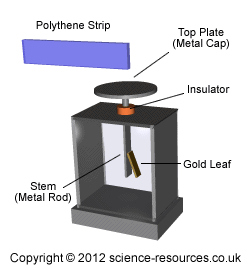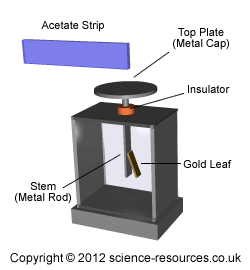i-How: Science - How does static electiricy work
Static build up is caused by friction
When two insulating materials are rubbed together, electrons are knocked off one and deposited on the other, this leaves a positive charge on one and a negative charge on the other. The classic example of this is when a polythene strip is rubbed with a duster.
Polythene Rod image courtesy of science-resources.co.uk
As demonstrated by the above example, when the polythene strip is rubbed with a duster, the electrons are scrapped off of the duster and deposited onto the polythene strip. The strip becomes negatively charged because it has more electrons and the cloth becomes positively charged because it has less electrons. Which way the electrons move depends on the two types of material.
Acetate Rod image courtesy of science-resources.co.uk
Note: As seen in both examples, only the electrons move, never the positive charges.
Opposites attract
As the old saying goes, opposites do attract! Two objects with opposite charges will be attracted to each other whereas two objects with same charges will repel each other. See examples below.

Opposite Charges Attract image courtesy of science-resources.co.uk

Like Charges Repel image courtesy of science-resources.co.uk
Note: If one object is charged and the other is not, both objects will be attracted to each other. This is called induction (see below)
When something that is charged comes in close contact with something that isn’t charged, the electrons in the neutral object move towards or away from the charged object The result of this is that the two objects are drawn together because the repelling charges are pushed further apart.
This is best demonstrated using a gold-leaf electroscope (see examples below)
 |
 |
Gold Leaf Experiment images courtesy of science-resources.co.uk
As the charge on an object builds up, so does the voltage between it and the Earth. If enough charge builds up, the charge can leap the gap, causing a spark. This can be prevented by discharging the object safely by connecting it to Earth with a metal strap. This is called earthing.
What causes an Electric shock?
You can receive an electrostatic shock if you build up a charge and you come in contact with something that is earthed.
When you walk across a carpet or vinyl floor, friction causes electrons to transfer to you. When you touch a conductive surface, such as a door knob, the electrons jump from you to the door knob, resulting in a shock.
How is static electricity used?
Spray Painting
Static electricity has many uses in everyday life. One example of this is spray painting.
How car spray painting works
- Cars are painted using an electrostatic spray paint
- The spray nozzle is given a positive (+) charge, this makes the spray droplets positively (+) charged.
- The car is connected to Earth, giving it a Negative (-) charge
- The positively (+) charged spray droplets repel each other, causing them to spread out. The positively (+) charged spray droplets are then attracted to the negatively (-) charged car, resulting in a perfect paint job
Electrostatic Paint Spray image courtesy of science-resources.co.uk
Other uses:
Static is also used to remove dust and pollution from chimneys. Electrostatic plates are placed inside the chimney to attract the dust particles. The dust particles are then collected in bags, these are sometimes known as electrostatic smoke precipitators.
Photocopiers and some printers make use of static charge to attract the toner and place it where you want it to appear on the paper.
You may also be interested in:
Tags: how static electricity works; what is static electricity; how does static electricity work; uses of static electricity; what is static electricity; earthing; charging by induction; friction; how does a Van de Graaff Generator work
